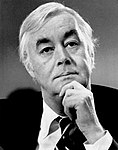Campaign
1994 was significant for the Republican Revolution, mostly as a referendum against President Bill Clinton and his health care plan, and was seen as a tough year for Democratic incumbents. Moynihan, however, was New York State's most popular politician at the time, and ran ahead of all other Democrats competing statewide. [3]
Republican Castro was running for office for the first time and had trouble raising funds due to being seen as unlikely to win; at times during the race she trailed by up to 30 percentage points. [3] She portrayed herself as a fiscally conservative, socially moderate Republican in the mold of Governor of New Jersey Christine Todd Whitman, and attempted to portray Moynihan as excessively liberal and prone to government spending. [3] But Moynihan repeated his past strong performance among upstate voters, in addition to the usual Democratic strongholds in New York City. [3]




